-

【高教版】中职数学拓展模块:2.2《双曲线》教学设计
教学准备 1. 教学目标 知识与技能掌握双曲线的定义,掌握双曲线的四种标准方程形式及其对应的焦点、准线.过程与方法掌握对双曲线标准方程的推导,进一步理解求曲线方程的方法——坐标法.通过本节课的学习,提高学生观察、类比、分析和概括的能力.情感、态度与价值观通过本节的学习,体验研究解析几何的基本思想,感受圆锥曲线在刻画现实和解决实际问题中的作用,进一步体会数形结合的思想.2. 教学重点/难点 教学重点双曲线的定义及焦点及双曲线标准方程.教学难点在推导双曲线标准方程的过程中,如何选择适当的坐标系. 3. 教学用具 多媒体4. 标签
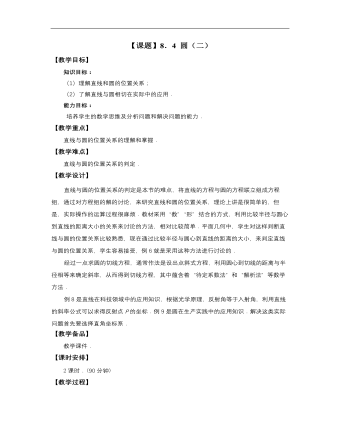
高教版中职数学基础模块下册:8.4《圆》教学设计
教 学 过 程教师 行为学生 行为教学 意图时间 *揭示课题 8.4 圆(二) *创设情境 兴趣导入 【知识回顾】 我们知道,平面内直线与圆的位置关系有三种(如图8-21): (1)相离:无交点; (2)相切:仅有一个交点; (3)相交:有两个交点. 并且知道,直线与圆的位置关系,可以由圆心到直线的距离d与半径r的关系来判别(如图8-22): (1):直线与圆相离; (2):直线与圆相切; (3):直线与圆相交. 介绍 讲解 说明 质疑 引导 分析 了解 思考 思考 带领 学生 分析 启发 学生思考 0 15*动脑思考 探索新知 【新知识】 设圆的标准方程为 , 则圆心C(a,b)到直线的距离为 . 比较d与r的大小,就可以判断直线与圆的位置关系. 讲解 说明 引领 分析 思考 理解 带领 学生 分析 30*巩固知识 典型例题 【知识巩固】 例6 判断下列各直线与圆的位置关系: ⑴直线, 圆; ⑵直线,圆. 解 ⑴ 由方程知,圆C的半径,圆心为. 圆心C到直线的距离为 , 由于,故直线与圆相交. ⑵ 将方程化成圆的标准方程,得 . 因此,圆心为,半径.圆心C到直线的距离为 , 即由于,所以直线与圆相交. 【想一想】 你是否可以找到判断直线与圆的位置关系的其他方法? *例7 过点作圆的切线,试求切线方程. 分析 求切线方程的关键是求出切线的斜率.可以利用原点到切线的距离等于半径的条件来确定. 解 设所求切线的斜率为,则切线方程为 , 即 . 圆的标准方程为 , 所以圆心,半径. 图8-23 圆心到切线的距离为 , 由于圆心到切线的距离与半径相等,所以 , 解得 . 故所求切线方程(如图8-23)为 , 即 或. 说明 例题7中所使用的方法是待定系数法,在利用代数方法研究几何问题中有着广泛的应用. 【想一想】 能否利用“切线垂直于过切点的半径”的几何性质求出切线方程? 说明 强调 引领 讲解 说明 引领 讲解 说明 观察 思考 主动 求解 思考 主动 求解 通过例题进一步领会 注意 观察 学生 是否 理解 知识 点 50
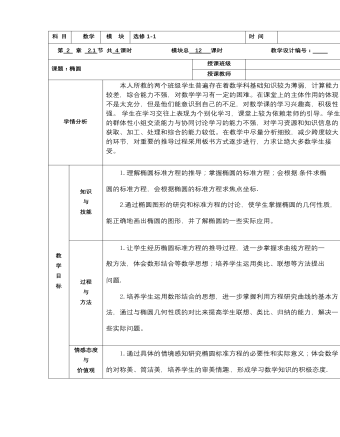
【高教版】中职数学拓展模块:2.1《椭圆》优秀教学设计
本人所教的两个班级学生普遍存在着数学科基础知识较为薄弱,计算能力较差,综合能力不强,对数学学习有一定的困难。在课堂上的主体作用的体现不是太充分,但是他们能意识到自己的不足,对数学课的学习兴趣高,积极性强。 学生在学习交往上表现为个别化学习,课堂上较为依赖老师的引导。学生的群体性小组交流能力与协同讨论学习的能力不强,对学习资源和知识信息的获取、加工、处理和综合的能力较低。在教学中尽量分析细致,减少跨度较大的环节,对重要的推导过程采用板书方式逐步进行,力求让绝大多数学生接受。 1.理解椭圆标准方程的推导;掌握椭圆的标准方程;会根据条件求椭圆的标准方程,会根据椭圆的标准方程求焦点坐标. 2.通过椭圆图形的研究和标准方程的讨论,使学生掌握椭圆的几何性质,能正确地画出椭圆的图形,并了解椭圆的一些实际应用。 1.让学生经历椭圆标准方程的推导过程,进一步掌握求曲线方程的一般方法,体会数形结合等数学思想;培养学生运用类比、联想等方法提出问题. 2.培养学生运用数形结合的思想,进一步掌握利用方程研究曲线的基本方法,通过与椭圆几何性质的对比来提高学生联想、类比、归纳的能力,解决一些实际问题。 1.通过具体的情境感知研究椭圆标准方程的必要性和实际意义;体会数学的对称美、简洁美,培养学生的审美情趣,形成学习数学知识的积极态度. 2.进一步理解并掌握代数知识在解析几何运算中的作用,提高解方程组和计算能力,通过“数”研究“形”,说明“数”与“形”存在矛盾的统一体中,通过“数”的变化研究“形”的本质。帮助学生建立勇于探索创新的精神和克服困难的信心。
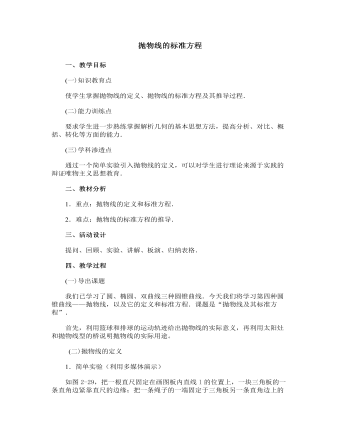
【高教版】中职数学拓展模块:2.3《抛物线》教学设计
一、教学目标(一)知识教育点使学生掌握抛物线的定义、抛物线的标准方程及其推导过程.(二)能力训练点要求学生进一步熟练掌握解析几何的基本思想方法,提高分析、对比、概括、转化等方面的能力.(三)学科渗透点通过一个简单实验引入抛物线的定义,可以对学生进行理论来源于实践的辩证唯物主义思想教育.二、教材分析1.重点:抛物线的定义和标准方程.2.难点:抛物线的标准方程的推导.三、活动设计提问、回顾、实验、讲解、板演、归纳表格.四、教学过程(一)导出课题我们已学习了圆、椭圆、双曲线三种圆锥曲线.今天我们将学习第四种圆锥曲线——抛物线,以及它的定义和标准方程.课题是“抛物线及其标准方程”.首先,利用篮球和排球的运动轨迹给出抛物线的实际意义,再利用太阳灶和抛物线型的桥说明抛物线的实际用途。
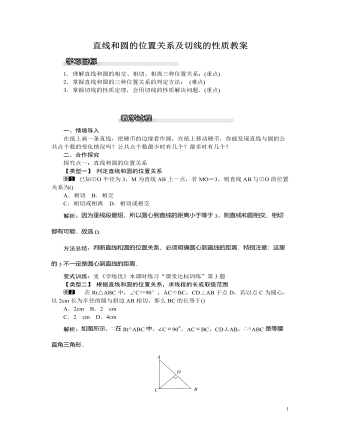
北师大初中九年级数学下册直线和圆的位置关系及切线的性质教案
解析:(1)由切线的性质得AB⊥BF,因为CD⊥AB,所以CD∥BF,由平行线的性质得∠ADC=∠F,由圆周角定理的推论得∠ABC=∠ADC,于是证得∠ABC=∠F;(2)连接BD.由直径所对的圆周角是直角得∠ADB=90°,因为∠ABF=90°,然后运用解直角三角形解答.(1)证明:∵BF为⊙O的切线,∴AB⊥BF.∵CD⊥AB,∴∠ABF=∠AHD=90°,∴CD∥BF.∴∠ADC=∠F.又∵∠ABC=∠ADC,∴∠ABC=∠F;(2)解:连接BD,∵AB为⊙O的直径,∴∠ADB=90°,∴∠A+∠ABD=90°.由(1)可知∠ABF=90°,∴∠ABD+∠DBF=90°,∴∠A=∠DBF.又∵∠A=∠C,∴∠C=∠DBF.在Rt△DBF中,sin∠DBF=sinC=35,DF=6,∴BF=10,∴BD=8.在Rt△ABD中,sinA=sinC=35,BD=8,∴AB=403.∴⊙O的半径为203.方法总结:运用切线的性质来进行计算或论证,常通过作辅助线连接圆心和切点,利用垂直构造直角三角形解决有关问题.
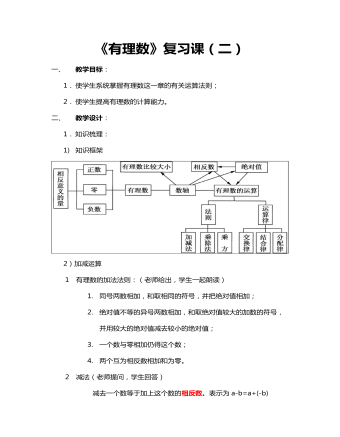
有理数复习教案教学设计
3)乘除运算①有理数的乘法法则:(老师给出,学生一起朗读)1. 两数相乘,同号得正,异号得负,并把绝对值相乘;2. 任何数与零相乘都得零;3. 几个不等于零的数相乘,积的符号由负因数的个数决定,当负因数有奇数个数,积为负;当负因数的个数为偶数个时,积为正;4. 几个有理数相乘,若其中有一个为零,积就为零。②有理数的除法法则:(老师提问,学生回答)1. 两个有理数相除,同号得正,异号得负,并把绝对值相除;2. 除以一个数等于乘以这个数的倒数。③关系(老师给出)除法转化为乘法进行运算。
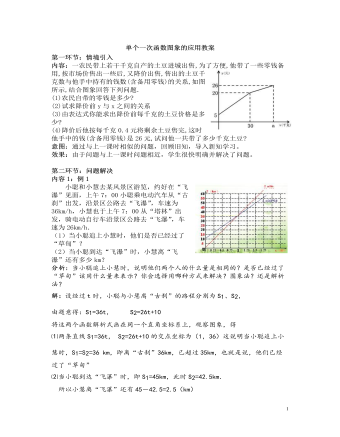
北师大初中数学八年级上册单个一次函数图象的应用2教案
(1)用简洁明快的语言概括大意,不能超过200字;(2)图表中能确定的数值,在故事叙述中不得少于3个,且要分别涉及时间、路和速度这三个量.意图:旨在检测学生的识图能力,可根据学生情况和上课情况适当调整。说明:练习注意了问题的梯度,由浅入深,一步步引导学生从不同的图象中获取信息,对同学的回答,教师给予点评,对回答问题暂时有困难的同学,教师应帮助他们树立信心。第四环节:课时小结内容:本节课我们学习了一次函数图象的应用,在运用一次函数解决实际问题时,可以直接从函数图象上获取信息解决问题,当然也可以设法得出各自对应的函数关系式,然后借助关系式完全通过计算解决问题。通过列出关系式解决问题时,一般首先判断关系式的特征,如两个变量之间是不是一次函数关系?当确定是一次函数关系时,可求出函数解析式,并运用一次函数的图象和性质进一步求得我们所需要的结果.
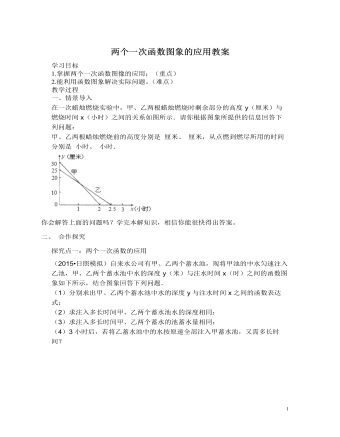
北师大初中数学八年级上册两个一次函数图象的应用2教案
学习目标1.掌握两个一次函数图像的应用;(重点)2.能利用函数图象解决实际问题。(难点)教学过程一、情景导入在一次蜡烛燃烧实验中,甲、乙两根蜡烛燃烧时剩余部分的高度y(厘米)与燃烧时间x(小时)之间的关系如图所示.请你根据图象所提供的信息回答下列问题:甲、乙两根蜡烛燃烧前的高度分别是 厘米、 厘米,从点燃到燃尽所用的时间分别是 小时、 小时.你会解答上面的问题吗?学完本解知识,相信你能很快得出答案。二、 合作探究探究点一:两个一次函数的应用(2015?日照模拟)自来水公司有甲、乙两个蓄水池,现将甲池的中水匀速注入乙池,甲、乙两个蓄水池中水的深度y(米)与注水时间x(时)之间的函数图象如下所示,结合图象回答下列问题.(1)分别求出甲、乙两个蓄水池中水的深度y与注水时间x之间的函数表达式;(2)求注入多长时间甲、乙两个蓄水池水的深度相同;(3)求注入多长时间甲、乙两个蓄水的池蓄水量相同;
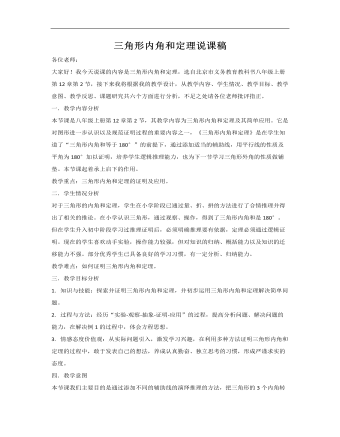
初中数学北京课改版八年级上册《122三角形的性质》说课稿
一.学生情况分析对于三角形的内角和定理,学生在小学阶段已通过量、折、拼的方法进行了合情推理并得出了相关的推论。在小学认识三角形,通过观察、操作,得到了三角形内角和是180°。但在学生升入初中阶段学习过推理证明后,必须明确推理要有依据,定理必须通过逻辑证明。现在的学生喜欢动手实验,操作能力较强,但对知识的归纳、概括能力以及知识的迁移能力不强。部分优秀学生已具备良好的学习习惯,有一定分析、归纳能力。
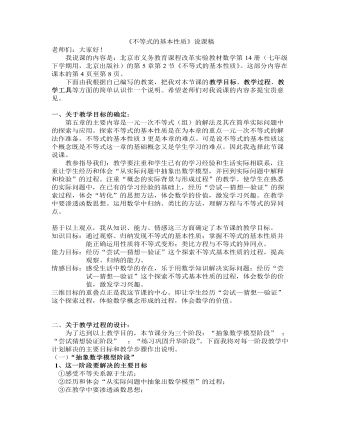
初中数学北京版七年级下册《不等式的基本性质》说课稿
一、关于教学目标的确定:第五章的主要内容是一元一次不等式(组)的解法及其在简单实际问题中的探索与应用。探索不等式的基本性质是在为本章的重点一元一次不等式的解法作准备。不等式的基本性质3更是本章的难点。可是说不等式的基本性质这个概念既是不等式这一章的基础概念又是学生学习的难点。因此我选择此节课说课。教参指导我们:教学要注重和学生已有的学习经验和生活实际相联系,注重让学生经历和体会“从实际问题中抽象出数学模型,并回到实际问题中解释和检验”的过程。注重“概念的实际背景与形成过程”的教学。使学生在熟悉的实际问题中,在已有的学习经验的基础上,经历“尝试—猜想—验证”的探索过程,体会“转化”的思想方法,体会数学的价值,激发学习兴趣。在教学中要渗透函数思想。运用数学中归纳、类比的方法,理解方程与不等式的异同点。
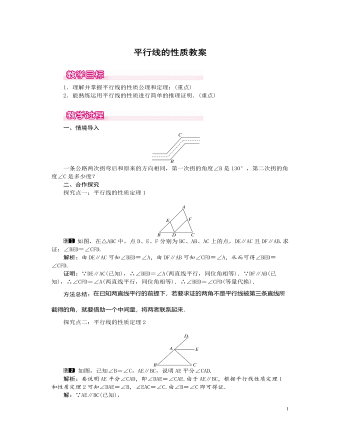
北师大初中数学八年级上册平行线的性质1教案
方法总结:平行线与角的大小关系、直线的位置关系是紧密联系在一起的.由两直线平行的位置关系得到两个相关角的数量关系,从而得到相应角的度数.探究点四:平行于同一条直线的两直线平行如图所示,AB∥CD.求证:∠B+∠BED+∠D=360°.解析:证明本题的关键是如何使平行线与要证的角发生联系,显然需作出辅助线,沟通已知和结论.已知AB∥CD,但没有一条直线既与AB相交,又与CD相交,所以需要作辅助线构造同位角、内错角或同旁内角,但是又要保证原有条件和结论的完整性,所以需要过点E作AB的平行线.证明:如图所示,过点E作EF∥AB,则有∠B+∠BEF=180°(两直线平行,同旁内角互补).又∵AB∥CD(已知),∴EF∥CD(如果两条直线都和第三条直线平行,那么这两条直线也互相平行),∴∠FED+∠D=180°(两直线平行,同旁内角互补).∴∠B+∠BEF+∠FED+∠D=180°+180°(等式的性质),即∠B+∠BED+∠D=360°.方法总结:过一点作一条直线或线段的平行线是我们常作的辅助线.
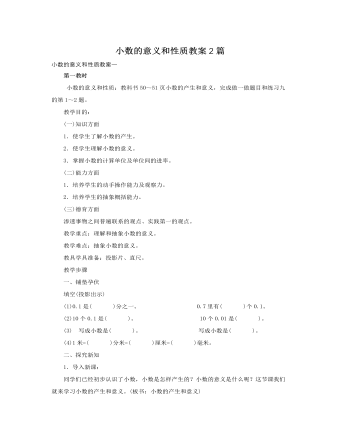
人教版新课标小学数学四年级下册小数的意义和性质教案2篇
用米作单位,用分数怎么表示呢?(1/10米)师:1/10米也可以写成0.1米。师:请同学们看米尺,从0到30,从0到70,应该是几分米,十分之几米?用小数怎样表示呢?可先和同桌商量商量。学生同桌讨论后反馈师根据反馈结果提问:请同学观察一下1/10米和0.1米,3/10米和0.3米,7/10米和0.7米之间有什么关系?随学生的回答出示1/10米=0.1米 3/10米=0.3米 7/10米=0.7米。再让学生观察上面的等式,四人小组讨论你发现了什么?使学生通过讨论明确:分母是10的分数可以写成一位小数,一位小数表示十分之几。2、 认识两位小数 、三位小数师:我们已经知道了一位小数表示十分之几,那么请同学猜一猜两位小数与什么样的分数有关?三位小数与什么样的分数有关?(具体的步骤和前面相似)让学生根据一位小数表示十分之几,猜想出两位小数和什么样的分数有关?有意识地促进“迁移”,使学生在学会的同时学习能力也得到提高。关于计数单位的教学我个人认为还是放到52页小数数位顺序表这里教学比较妥当。
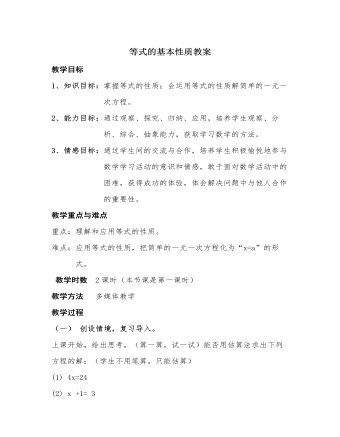
北师大初中七年级数学上册等式的基本性质教案2
教学目标1、知识目标:掌握等式的性质;会运用等式的性质解简单的一元一次方程。2、能力目标:通过观察、探究、归纳、应用,培养学生观察、分析、综合、抽象能力,获取学习数学的方法。3、情感目标:通过学生间的交流与合作,培养学生积极愉悦地参与数学学习活动的意识和情感,敢于面对数学活动中的困难,获得成功的体验,体会解决问题中与他人合作的重要性。教学重点与难点重点:理解和应用等式的性质。难点:应用等式的性质,把简单的一元一次方程化为“x=a”的形式。教学时数 2课时(本节课是第一课时)教学方法 多媒体教学教学过程(一) 创设情境,复习导入。上课开始,给出思考,(算一算,试一试)能否用估算法求出下列方程的解:(学生不用笔算,只能估算)
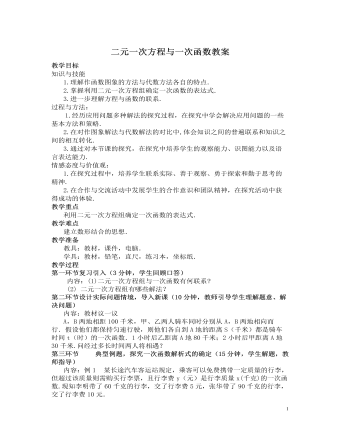
北师大初中数学八年级上册二元一次方程与一次函数2教案
2. 在弹性限度内,弹簧的长度y(厘米)是所挂物体质量x(千克)的一次函数.当所挂物体的质量为1千克时弹簧长15厘米;当所挂物体的质量为3千克时,弹簧长16厘米.写出y与x之间的函数关系式,并求当所挂物体的质量为4千克时弹簧的长度.答案: 当x=4是,y= 3. 教材例2的再探索:我边防局接到情报,近海处有一可疑船只A正向公海方向行驶.边防局迅速派出快艇B追赶,如图所示, , 分别表示两船相对于海岸的距离s(海里)与追赶时间t(分)之间的关系.当时间t等于多少分钟时,我边防快艇B能够追赶上A。答案:直线 的解析式: ,直线 的解析式: 15分钟第五环节课堂小结(2分钟,教师引导学生总结)内容:一、函数与方程之间的关系.二、在解决实际问题时从不同角度思考问题,就会得到不一样的方法,从而拓展自己的思维.三、掌握利用二元一次方程组求一次函数表达式的一般步骤:1.用含字母的系数设出一次函数的表达式: ;2.将已知条件代入上述表达式中得k,b的二元一次方程组;3.解这个二元一次方程组得k,b,进而得到一次函数的表达式.
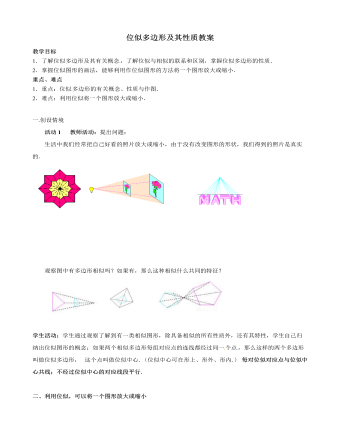
北师大初中数学九年级上册位似多边形及其性质2教案
(3)分别在射线OA,OB,OC,OD上取点A′、B′、C′、D′,使得 ;(4)顺次连接A ′B′、B′C′、C′D′、D′A′,得到所要画的四边形A′B′C′D′,如图2.问:此题目还可以 如何画出图形?作法二 :(1)在四边形ABCD外任取一点 O;(2)过点O分别作射线OA, OB, OC,OD;(3)分别在射线OA, OB, OC, OD的反向延长线上取点A′、B′、C′、D′,使得 ;(4)顺次连接A ′B′、B′ C′、C′D′、D′A′,得到所 要画的四边形A′B′C′D′,如图3. 作法三:(1)在四边形ABCD内任取一点O;(2)过点O分别作 射线OA,OB,OC,OD;(3)分别在射线OA,OB,OC,OD上取点A′、B′、C′、D′,使得 ;(4)顺次连接A′B′、B′C ′、C′D′、D′A′,得到所要画的四边形A′B′C′D′,如图4.(当点O在四边形ABCD的一条边上或在四边形ABCD的一个顶点上时,作法略——可以让学生自己完成)三、课堂练习 活动3 教材习题小结:谈谈你这节课学习的收获.
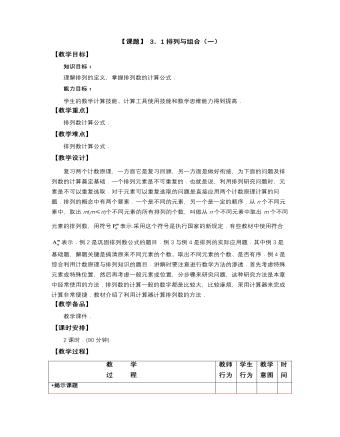
【高教版】中职数学拓展模块:3.1《排列与组合》优秀教学设计
教 学 过 程教师 行为学生 行为教学 意图时间 *揭示课题 3.1 排列与组合. *创设情境 兴趣导入 基础模块中,曾经学习了两个计数原理.大家知道: (1)如果完成一件事,有N类方式.第一类方式有k1种方法,第二类方式有k2种方法,……,第n类方式有kn种方法,那么完成这件事的方法共有 = + +…+(种). (3.1) (2)如果完成一件事,需要分成N个步骤.完成第1个步骤有k1种方法,完成第2个步骤有k2种方法,……,完成第n个步骤有kn种方法,并且只有这n个步骤都完成后,这件事才能完成,那么完成这件事的方法共有 = · ·…·(种). (3.2) 下面看一个问题: 在北京、重庆、上海3个民航站之间的直达航线,需要准备多少种不同的机票? 这个问题就是从北京、重庆、上海3个民航站中,每次取出2个站,按照起点在前,终点在后的顺序排列,求不同的排列方法的总数. 首先确定机票的起点,从3个民航站中任意选取1个,有3种不同的方法;然后确定机票的终点,从剩余的2个民航站中任意选取1个,有2种不同的方法.根据分步计数原理,共有3×2=6种不同的方法,即需要准备6种不同的飞机票: 北京→重庆,北京→上海,重庆→北京,重庆→上海,上海→北京,上海→重庆. 介绍 播放 课件 质疑 了解 观看 课件 思考 引导 启发学生得出结果 0 15*动脑思考 探索新知 我们将被取的对象(如上面问题中的民航站)叫做元素,上面的问题就是:从3个不同元素中,任取2个,按照一定的顺序排成一列,可以得到多少种不同的排列. 一般地,从n个不同元素中,任取m (m≤n)个元素,按照一定的顺序排成一列,叫做从n个不同元素中取出m个元素的一个排列,时叫做选排列,时叫做全排列. 总结 归纳 分析 关键 词语 思考 理解 记忆 引导学生发现解决问题方法 20
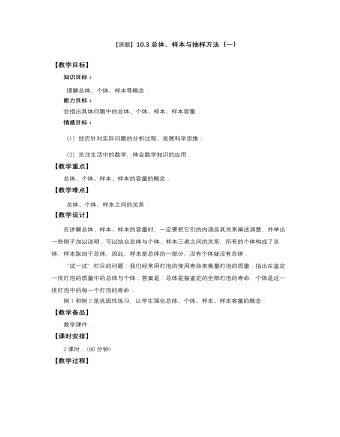
高教版中职数学基础模块下册:10.3《总体、样本与抽样方法》教学设计
教 学 过 程教师 行为学生 行为教学 意图时间 *揭示课题 10.3总体、样本与抽样方法(一) *创设情境 兴趣导入 【实验】 商店进了一批苹果,小王从中任意选取了10个苹果,编上号并称出质量.得到下面的数据(如表10-6所示): 苹果编号12345678910质量(kg)0.210.170.190.160.200.220.210.180.190.17 利用这些数据,就可以估计出这批苹果的平均质量及苹果的大小是否均匀. 介绍 质疑 讲解 说明 了解 思考 启发 学生思考 0 10*动脑思考 探索新知 【新知识】 在统计中,所研究对象的全体叫做总体,组成总体的每个对象叫做个体. 上面的实验中,这批苹果的质量是研究对象的总体,每个苹果的质量是研究的个体. 讲解 说明 引领 分析 理解 记忆 带领 学生 分析 20*巩固知识 典型例题 【知识巩固】 例1 研究某班学生上学期数学期末考试成绩,指出其中的总体与个体. 解 该班所有学生的数学期末考试成绩是总体,每一个学生的数学期末考试成绩是个体. 【试一试】 我们经常用灯泡的使用寿命来衡量灯炮的质量.指出在鉴定一批灯泡的质量中的总体与个体. 说明 强调 引领 观察 思考 主动 求解 通过例题进一步领会 35
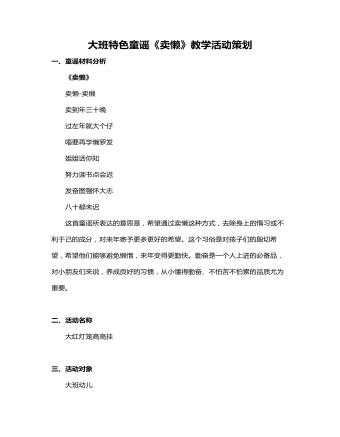
《卖懒》教学设计教案
1.制作红灯笼师:(展示漂亮的灯笼)小朋友们想不想自己亲手制作一个呢?生:好呀师:那小朋友们知道制作灯笼需要什么材料吗?生:彩纸、剪刀...师:没错,那老师先来展示一下怎么制作灯笼吧!(展示完后,开始让小朋友两两组合共同制作)2.制作灯笼剪纸师:小朋友们,刚刚是不是已经制作灯笼了呀?下面我们进行一个更好玩的环节?生:好呀好呀!师:那我先来展示一下咯,小朋友们别眨眼呀!(展示完后,开始让小朋友们独立完成)小结:通过制作共同合作制作灯笼与独自完成灯笼剪影,不仅使他们更能感知灯笼的形状,更能提高小朋友们的动手能力和思考力。
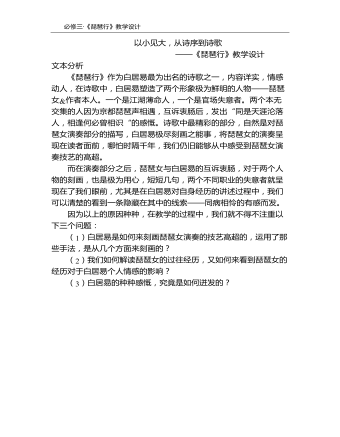
《琵琶行》教学设计
文本分析《琵琶行》作为白居易最为出名的诗歌之一,内容详实,情感动人,在诗歌中,白居易塑造了两个形象极为鲜明的人物——琵琶女&作者本人。一个是江湖薄命人,一个是官场失意者。两个本无交集的人因为京都琵琶声相遇,互诉衷肠后,发出“同是天涯沦落人,相逢何必曾相识“的感慨
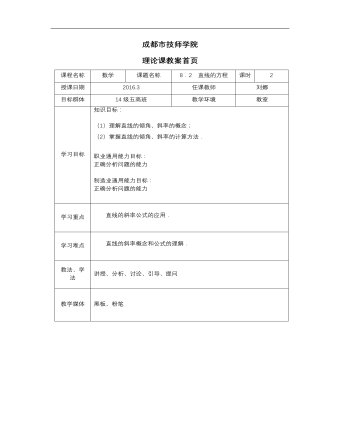
高教版中职数学基础模块下册:8.2《直线的方程》教学设计
课程名称数学课题名称8.2 直线的方程课时2授课日期2016.3任课教师刘娜目标群体14级五高班教学环境教室学习目标知识目标: (1)理解直线的倾角、斜率的概念; (2)掌握直线的倾角、斜率的计算方法. 职业通用能力目标: 正确分析问题的能力 制造业通用能力目标: 正确分析问题的能力学习重点直线的斜率公式的应用.学习难点直线的斜率概念和公式的理解.教法、学法讲授、分析、讨论、引导、提问教学媒体黑板、粉笔





















